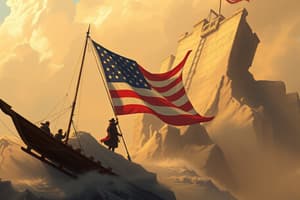Podcast
Questions and Answers
What does mercantilism primarily emphasize?
What does mercantilism primarily emphasize?
- Trade routes to Asia
- Religious freedom
- Accumulation of gold and silver (correct)
- Colonization of Africa
What significant achievement is credited to Christopher Columbus?
What significant achievement is credited to Christopher Columbus?
- Landing on the Bahamas in 1492 (correct)
- Circumnavigating the globe
- Finding a new trade route to India
- Discovering the Bering Strait
What event led to the decline of the Spanish Armada?
What event led to the decline of the Spanish Armada?
- Overconfidence in their fleet
- Alliances with England
- A brutal storm (correct)
- Defeat by the French Navy
Which of the following best describes a conquistador?
Which of the following best describes a conquistador?
What does the term 'Pueblo' refer to?
What does the term 'Pueblo' refer to?
Flashcards are hidden until you start studying
Study Notes
Key Themes and Concepts in US History - Chapter One
-
Mercantilism: An economic theory that emphasizes the role of the state in managing trade and commerce to increase national wealth, ensuring a favorable balance of trade.
-
Christopher Columbus: An Italian explorer, sponsored by Spain, who made four voyages across the Atlantic, discovering the Americas in 1492, mistaking them for Asia.
-
Spanish Armada: A fleet of 130 ships sent by Spain in 1588 to invade England; it failed due to poor weather and tactical naval battles, leading to a significant decline in Spanish naval power.
-
Circumnavigate: To sail completely around the world; first achieved by Ferdinand Magellan's expedition, which demonstrated the vastness of the Earth and global navigation possibilities.
-
Protestant Reformation: A religious movement in the 16th century aimed at reforming the Catholic Church, leading to the establishment of Protestant denominations and significant political and social changes in Europe.
-
Bering Strait: A narrow passage between Russia and Alaska, believed to be a land bridge that early humans used to migrate from Asia to North America.
-
Compass: An instrument that shows the direction of magnetic north; crucial for navigation, especially during the Age of Exploration.
-
Astrolabe: An ancient tool used by explorers to determine latitude by measuring the position of the sun and stars, improving navigation accuracy at sea.
-
Caravel: A small, highly maneuverable sailing ship developed in the 15th century, allowing for exploration and long voyages due to its speed and ability to sail against the wind.
-
Pueblo: A Spanish term meaning "village," referring to the adobe dwelling of Native American tribes in the Southwest United States, known for their complex multi-story structures.
-
Conquistador: Spanish explorers and soldiers who conquered lands in the Americas, often associated with the colonization and exploitation of indigenous peoples.
-
Aztec King: Montezuma II, the ninth ruler of the Aztec Empire, known for his wealth, power, and the eventual encounter with Spanish conquistador Hernán Cortés.
-
Oldest Permanent European Settlement: St. Augustine, Florida, founded by the Spanish in 1565, recognized as the oldest continuously inhabited city in the continental United States.
-
Henry Hudson: An English explorer known for his explorations of North America in the early 17th century, including the Hudson River and Hudson Bay, contributing to Dutch claims on the region.
-
Founder of Virginia: Sir Walter Raleigh established the Roanoke Colony, the first English settlement in North America, officially noting the beginnings of Virginia.
-
"Lost Colony" Inscription: The word "Croatoan" carved into a tree by settlers of Roanoke Island, hinting at their fate or potential relocation but leaving their disappearance a mystery.
-
Spanish Armada Composition: Comprising approximately 130 ships and around 30,000 men, the Spanish Armada was a symbol of Spain's naval dominance and its efforts to assert control over Europe.
Studying That Suits You
Use AI to generate personalized quizzes and flashcards to suit your learning preferences.




